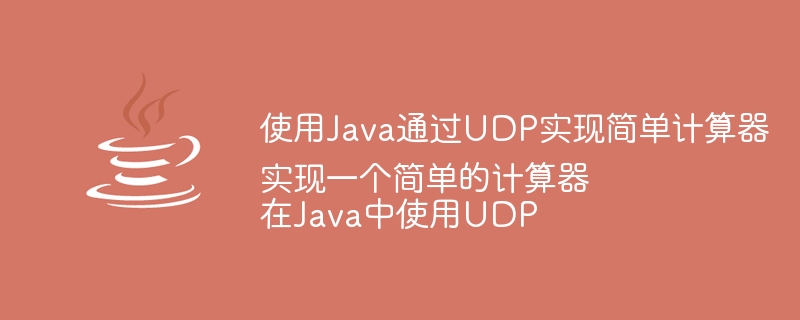Home >Java >javaTutorial >Implementing a simple calculator over UDP using Java Implement a simple calculator using UDP in Java
Implementing a simple calculator over UDP using Java Implement a simple calculator using UDP in Java
- 王林forward
- 2023-08-27 21:33:021198browse

The Internet Protocol Suite contains all types of protocols that enable devices to communicate with each other over the Internet. UDP is one of the protocols of this suite, and its full form is User Datagram Protocol. Unlike TCP, it is unreliable and a connectionless protocol. It does not establish any type of connection with other devices before sending data.
In this article, we will develop a simple client-server calculator using UDP in Java. The client requests an operation, and the server calculates and sends the result to the client device.
Java Network
Let us first briefly understand some basic concepts about Java networking−
Inet address
An IP address is a 32-bit or 128-bit unsigned number that uniquely identifies a device on the Internet. It's easier to remember the name of an IP host than the numeric address. Therefore, we need to use the "InetAddress" class to encapsulate it. We use its built-in method "getLocalHost()" to get the IP address of the local host.
Datagram
They are small packets containing data that can be passed between two machines over the Internet. Java implements two classes to establish UDP connections -
DatagramSocket class is used to send and receive datagram packets. It also determines the destination of these packages. Its built-in methods 'send()' and 'receive()' are used to send and receive data packets respectively.
grammar
DatagramSocket nameOfObject = new DatagramSocket();The object of class
DatagramPacket stores the data to be sent.
grammar
DatagramPacket nameOfPacket = new DatagramPacket();
Calculator program using UDP
Client program
How the code works
We first import the two most important packages named 'java.net' which is used to access all classes related to Java networking, and 'java.io' , for input and output streams. Use the 'java.util' package to use the 'Scanner' class.
Establish a UDP connection and then obtain the local host address.
Now, inside the try block, we will request user input through the 'send()' and 'receive()' methods of the 'DatagramSocket' class to request the operation and receive the result accordingly.
import java.io.*;
import java.net.*;
import java.util.*;
public class ClientCalc {
public static void main(String args[]) throws IOException {
Scanner inp = new Scanner(System.in);
// making UDP connection
DatagramSocket datagsokt = new DatagramSocket();
// fetching the localhost address
InetAddress addr = InetAddress.getLocalHost();
byte strm[] = null;
try {
while (true) {
System.out.println("Type 1 for Addition");
System.out.println("Type 2 for Subtraction");
System.out.println("Type 3 for Multiplication");
System.out.println("Type 4 for Division");
System.out.println("Enter your choice: ");
String oprtr = inp.nextLine();
// to convert the user choice to byte
strm = new byte[256];
strm = oprtr.getBytes();
// creating datagram packet to send to server
DatagramPacket packtsend = new DatagramPacket(strm, strm.length, addr, 6666);
datagsokt.send(packtsend);
// Type 0 for cut the connection
if (oprtr.equals("0")) {
break;
}
// to receive the result from server
strm = new byte[256];
DatagramPacket packtrec = new DatagramPacket(strm, strm.length);
datagsokt.receive(packtrec);
// display the result
System.out.println("Your Result for the given operation = " + new String(strm, 0, strm.length));
}
}
// to handle exception
catch(Exception exp) {
System.out.println(exp);
}
}
}
Server-side program
How the code works
-
First, establish a connection with the client and define two objects of the DatagramPacket class to send and receive data packets using the "send()" and "receive()" methods of the "DatagramSocket" class.
Inside the try block, we receive the request from the client and then use switch case to perform the operation and send the result to the client device.
Example
import java.io.*;
import java.net.*;
class ServerCalc {
public static void main(String[] args) throws IOException {
// making connection to client
DatagramSocket datagsokt = new DatagramSocket(6666);
byte[] strm = null;
DatagramPacket packtrec = null;
DatagramPacket packtsend = null;
try {
while (true) {
strm = new byte[256];
// to receive the packet from client
packtrec = new DatagramPacket(strm, strm.length);
datagsokt.receive(packtrec);
String oprtr = new String(strm, 0, strm.length);
System.out.println("Client has requested for " + oprtr );
int data1 = 15;
int data2 = 5;
int tot = 0;
char opt = oprtr.charAt(0);
switch(opt) {
case '1' :
tot = data1 + data2;
break;
case '2' :
tot = data1 - data2;
break;
case '3' :
tot = data1 * data2;
break;
case '4' :
tot = data1 / data2;
break;
default :
break;
}
// Converting the string result to integer
String res = Integer.toString(tot);
// converting the integer to bytes
strm = res.getBytes();
int port = packtrec.getPort();
// getting port number
// sending final result in the form of datagram packet
packtsend = new DatagramPacket(strm, strm.length, InetAddress.getLocalHost(), port);
datagsokt.send(packtsend);
}
}
// to handle exception
catch(Exception exp) {
System.out.println(exp);
}
}
}
To run both programs at the same time, open both cmds simultaneously on your local machine. On the first cmd interface, compile and run the server-side program, and then execute the client program on the other interface.
Client output
D:\Java Programs>java ClientCalc Type 1 for Addition Type 2 for Subtraction Type 3 for Multiplication Type 4 for Division Enter your choice: 1 Your Result for the given operation = 20
Server-side output
D:\Java Programs>java ServerCalc Client has requested for 1
When we enter 0, the connection will be terminated and the program will stop executing.
in conclusion
In this article, we learned about some basic concepts of Java networking. Additionally, we discussed server-side and client-side programs for a simple calculator using UDP. We discovered how to establish a connection between client and server devices using Java.
The above is the detailed content of Implementing a simple calculator over UDP using Java Implement a simple calculator using UDP in Java. For more information, please follow other related articles on the PHP Chinese website!

